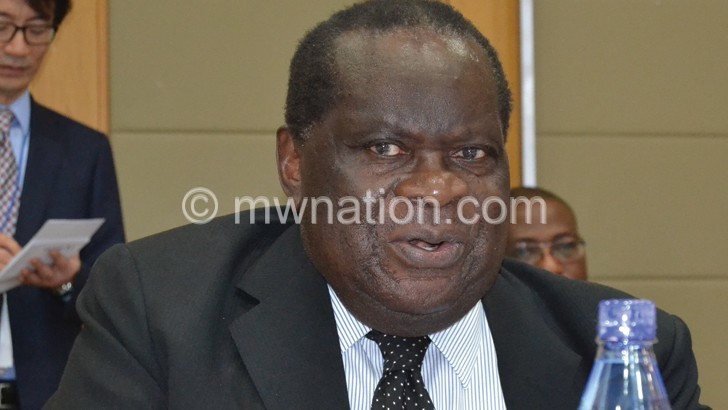Government plays with K10bn
Admarc is throwing away over K10 billion after government ordered the parastatal to cut by 44 percent the price of its maize stock estimated at 90 000 tonnes, The Nation analysis shows.
In a written response on Tuesday, the produce trader confirmed that the Ministry of Agriculture, Irrigation and Water Development has directed it to slash the maize price from K270 per kilogramme (kg) to K150 per kg, which is a 44 percent cut.
In his 2017/18 Mid-Year Budget Review Statement earlier this year, Finance, Economic Planning and Development Minister Goodall Gondwe said Admarc had 90 000 tonnes of maize in its depots.

Had the Agricultural Development and Marketing Corporation (Admarc) sold the maize at K270 as planned, the parastatal could have raked in K24.3 billion in revenue.
But the corporation may now only make around K13.5 billion by selling it at the slashed price of K150 per kg, leaving it with an income loss of K10.8 billion that it can ill-afford.
Admarc spokesperson Agness Chikoko said the corporation knows it will make losses due to the price cut.
She, however, said Admarc has no choice, but to follow the government directive to execute the social component of its mandate.
Chikoko said: “Yes, we wish to confirm that it has pleased government to reduce the price of maize from K270/kg to K150/kg. Please be informed that Admarc only buys maize on behalf of government and it is government that controls the price of buying and selling maize in the country. Admarc does not set maize prices.”
In a separate interview on Tuesday, Admarc board chairperson James Masumbu said the parastatal suffers huge losses in such situations, adding; “that is why we always say that when doing that, we are doing a social function on behalf of government.”
But this is the same Masumbu who vehemently rejected pleas last February for the parastatal to cut maize prices. At the time, he argued that the basis for the pricing had not changed and, therefore, it did not make business sense to reduce prices.
On his part, Ministry of Agriculture, Irrigation and Water Development spokesperson Osborne Tsoka on Tuesday said government sets deliberate policies that keep maize, being a staple food, affordable to the masses, particularly those in rural areas.
“Therefore, by adjusting the prices it ensures that maize is accessible if we are to talk about food security,” he said.
But that empathy for the poor did not appear to be the thinking in October 2016 when President Peter Mutharika ordered a 127 percent price hike on the staple grain from K5 500 per 50kg bag to K12 500.
Said Mutharika at the time: “I have instructed that Admarc should be selling the maize at K250 per kilogramme, the same price they were buying.”
By January 2017, some stakeholders—including the Parliamentary Committee on Agriculture and the Centre for Social Concern—were urging Mutharika to cut the maize prices, but it never worked.
Twenty months after that presidential directive—and nine months to the next election—the idea of cutting maize prices to help the poor, even when the bulk of Admarc’s stock is the same that was set to be sold at K250 per kg because that was its buying price, is now appealing.
Asked if the reduction will not result in losses for Admarc, Tsoka said the company is not there to make profits.
Said Tsoka: “Admarc purchases maize on behalf of government and government’s objective is to ensure that maize is affordable and accessible to all Malawians. The prices of maize should be around the minimum farm gate price as set by the government.”
But the cut in Admarc’s maize price still leaves the parastatal’s stock more expensive than private traders, who are selling the staple grain at around K6 800 per 50 kg bag or K136 per kg—lower than the grain trader’s K7 500 per 50 kg bag or K150 per kg.
The private traders can afford to outprice Admarc because they bought the maize cheaply from farmers at harvest time while the parastatal was running around trying to raise capital.
Gondwe had banked on proceeds that Admarc would realise from the maize sales to help recover for the taxpayer the K45.2 billion that Treasury used to bailout the parastatal out of its debt hole.
During the 2016/17 financial year, government issued Admarc with a guarantee of K38.4 billion to obtain commercial bank loans to buy grain stocks within the country and help avert an envisaged acute maize shortage.
“It, however, transpired that Admarc did not sell the maize to repay the loans because it turned out that the food shortage was far less than envisaged. Therefore, government had to bail out Admarc. The bailout totalled K45.2 billion of which K6.8 billion was interest,” said Gondwe.
Admarc’s well-known inefficiencies aside—government should also take the blame for the financial mess the parastatal found itself in and which taxpayers’ were forced to pay for.
Earlier last year, Admarc had an opportunity to export the maize it has been stuck with to Kenya, Tanzania and even Zambia, but President Mutharika cancelled the move, and proceeded to impose a maize export ban that is now haunting the parastatal and other maize traders whose working capital is stuck in stock they cannot sell at margins that make business sense.
At the time, Admarc had the maize export opportunity, it was sitting on 100 000 tonnes of maize valued at $34 million (around K24 billion), now cut to just over K13 billion on account of the price slash.





